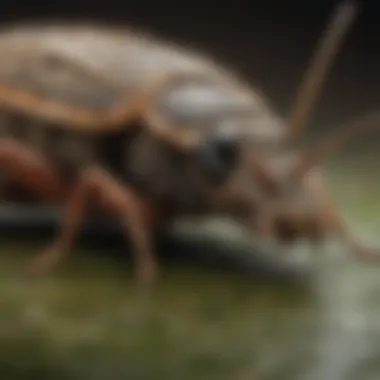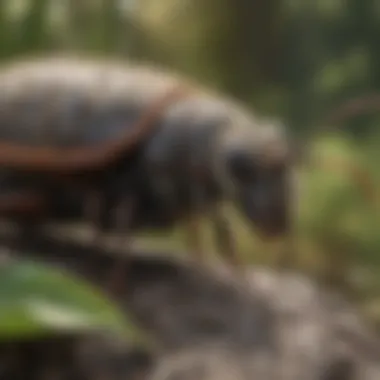Highlands Pest Management: Strategies and Considerations


Intro
Pest management in highland regions presents unique challenges. Altitudes, climate variations, and diverse ecosystems affect how pests behave and interact with their environment. Identifying these factors is crucial for homeowners and gardeners to implement effective control measures. This article aims to explore tailored strategies for managing pests in highland areas effectively, aiding individuals in navigating this complex landscape.
Understanding the specific habitats and conditions of pests is key for anyone involved in pest management. Homeowners need practical solutions that can adapt to the distinct characteristics of their region.
Understanding Pests
Definition of Pests
Pests are organisms that cause harm to human interests, be it in agriculture, gardening, or the structural integrity of homes. Common pests in highland environments include certain insects, rodents, and fungi. Their presence can lead to damage in gardens and homes, leading to loss in yields and increased maintenance costs.
Importance of Pest Identification
Identifying pests accurately is essential for effective management. Misidentification can lead to the wrong control strategies, often worsening the problem. For instance, some insects might be beneficial, contributing to pollination or controlling harmful pests. Recognizing signs of infestation early can lead to timely interventions, protecting your property and plants.
Prevention Techniques
Home and Garden Preventative Measures
Preventing pest infestations begins at home. Here are some strategies:
- Seal entry points: Inspect your house for cracks and openings. Use caulk or weather stripping to seal these areas.
- Maintain cleanliness: Proper sanitation reduces pest attraction. Store food in airtight containers and keep living areas tidy.
- Mulch and compost smartly: Use mulch to suppress weeds but be cautious as it can attract certain pests. Compost properly to deter rodents.
Seasonal Prevention Tips
Seasonality affects pest behavior. Adjust your strategies accordingly:
- Spring: Monitor new growth for pests emerging from winter hibernation.
- Summer: Increase vigilance as many pests reproduce rapidly in warm weather.
- Fall: Prepare your home to prevent pests from seeking shelter indoors during colder months.
- Winter: Inspect for hidden infestations, as some pests thrive in warmer indoor environments.
Eco-Friendly Pest Control Solutions
Overview of Sustainable Practices
Employing eco-friendly pest control practices benefits the environment and human health. Here are some essential practices:
- Integrated Pest Management (IPM): This strategy combines biological, physical, cultural, and chemical tools in a way that minimizes risks.
- Water management: Excess moisture can attract pests. Proper drainage techniques create less favorable conditions for pest breeding.
Natural Remedies and Their Effectiveness
Natural remedies can also serve as an effective tool in pest management:
- Neem oil: Derived from the neem tree, it disrupts pest development and acts as a repellent.
- Diatomaceous earth: This powdery substance can eliminate pests by dehydrating them upon contact.
Natural remedies often require consistent application for noticeable results.
By integrating these strategies, homeowners can develop a comprehensive pest management plan tailored for highland conditions.
Understanding Highlands Ecosystems
Highland ecosystems are crucial when it comes to managing pest issues. These unique environments present specific challenges that must be understood to devise effective control strategies. Understanding the interplay between altitude, climate, flora, and fauna is essential. The benefits of grasping these dynamics can lead to more effective pest control solutions and sustainable practices.
Defining Highland Regions
Highland regions are characterized by their elevated landscapes, often found at altitudes exceeding 3000 feet. They encompass a variety of geographical features. These may include mountains, plateaus, and high-altitude valleys. The definition of highlands can also vary based on local context. Different regions around the world may classify their own highlands using specific criteria. Nevertheless, highland areas typically display a unique set of climatic and ecological characteristics that differentiate them from lowland regions.
Climate Characteristics
The climate in highland areas can be unpredictable. Generally, they experience cooler temperatures compared to surrounding lowlands. The elevation often leads to variations in weather patterns. Frequent rainfall and fluctuating temperatures can create moist conditions, ideal for various pests. Furthermore, shorter growing seasons in these areas can influence the types of crops and gardens grown, affecting pest behaviors and populations. Awareness of this climate variability is a necessary factor in preparing for potential pest challenges.
Flora and Fauna Diversity
The biodiversity observed in highland ecosystems is remarkably rich. Both flora and fauna adapt to the challenging conditions of high altitudes. The types of plants found in these regions include unique species that may not thrive anywhere else. Grasslands, alpine flowers, and shrubs contribute to a diverse habitat that supports many organisms.
In terms of fauna, highland ecosystems host various insect species, birds, and mammals adapted to the specific environmental conditions. This diversity plays a crucial role in pest management as both natural predators and competitors. Knowing the plant and animal species present can guide effective pest control strategies. Understanding which species are beneficial can help in fostering a balanced ecosystem.
"Effective pest management hinges on a deep understanding of the ecosystems in which pests thrive. Adaptive strategies must consider local flora and fauna to achieve sustainability."
Overall, understanding highland ecosystems is pivotal to developing appropriate pest management strategies that are both effective and eco-friendly.
Identifying Common Highland Pests
Identifying common pests in highland regions is a crucial step in pest management. Understanding which pests are frequent in this ecosystem helps homeowners and gardeners to formulate proper strategies. Highland areas often have a unique set of challenges regarding pest presence. This might relate to the specific species that thrive at high altitudes and the varying climates.


By knowing the types of pests prevalent in their areas, residents can make informed choices regarding prevention and control. Moreover, accurate identification helps in recognizing the level of infestation, allowing for timely and effective management actions. Addressing pest issues early can minimize damage to yards, gardens, and crops, resulting in healthier plants and more productive harvests.
Insects Specific to Highland Areas
Highland regions host various insect species that can pose significant challenges.
Some common insects include:
- Aphids: These small insects feed on plant sap, weakening plants and causing them to wilt. They are known for reproducing rapidly under favorable conditions.
- Leafhoppers: Leafhoppers can transmit plant diseases as they jump from one plant to another. Their presence can lead to stunted growth and yield reduction.
- Mountain Pine Beetles: These beetles target pine trees, often causing extensive damage in forested regions and affecting the ecological balance.
Proper monitoring of botanical health is key. Recognizing the signs of pest activity can help avoid greater problems later.
Rodents and Larger Pests
Unwelcome visitors, such as rodents, frequently invade highland homes and gardens. Common rodents include:
- Meadow Voles: They can nibble on crops and ornamental plants, leading to substantial losses in gardens.
- Chipmunks: Chipmunks are often seen in highland areas, stealing seeds and feeding on tender shoots.
Larger pests like deer may also cause troubles by grazing on plantings. Homeowners must find ways to protect their landscape and gardens from such intruders, protecting precious resources designed for growth.
Impact on Agriculture and Gardens
The presence of pests can have profound consequences for both farming and home gardening in highland regions.
These consequences include:
- Reduced Crop Yields: High populations of pests can lead to lower amounts of produce, impacting daily life and income for farmers.
- Plant Health: Continuous feeding can compromise plant health, making them more susceptible to diseases.
- Economic Strain: Managing pest-related damage often incurs costs for pesticide usage, equipment, and sometimes repair of damaged crops or plants.
To mitigate these challenges, residents should be educated about the types of pests threatening their resources. With the right strategies, such as employing pest-resistant varieties and practicing crop rotation, one can maintain healthy agricultural practices.
Challenges in Pest Management
Pest management in highland environments presents unique challenges that homeowners and pest control professionals must navigate. The specific conditions of these regions, including altitude, seasonal shifts, and pest behaviors, necessitate tailored strategies. These challenges not only influence the effectiveness of pest control methods but also impact broader ecological dynamics and agricultural productivity. Understanding these difficulties allows stakeholders to develop more sustainable and effective pest management solutions while minimizing potential harm to the environment.
Altitude-Related Factors
Altitude plays a significant role in shaping the ecosystems of highland areas. While higher elevations can limit the variety of pests typically found in warmer climates, they also present new challenges. Insects such as the mountain pine beetle can thrive in cooler temperatures, and their populations may flourish in favorable conditions. Moreover, pests often experience slower life cycles at higher altitudes, which can affect their reproductive rates and feeding habits.
Low oxygen levels can also impact pest behavior. For example, rodents may migrate to lower elevations during winter in search of food sources, potentially leading to increased competition as they invade lower-lying habitats. Therefore, pest management strategies must be adaptive to ensure they address the subtleties introduced by altitude.
Seasonal Variability and Ecosystem Changes
Highland ecosystems are subject to seasonal variability that profoundly affects pest populations. The shifts in temperature and precipitation patterns throughout the year can influence when pests emerge and how abundantly they reproduce. For instance, warmer winters may lead to an early emergence of certain insect species, allowing their populations to grow unchecked.
Ecosystem changes, such as those triggered by human activity or climate change, can also shift pest dynamics. When native plant species decline, invasive species may flourish, bringing with them pests that are not typically found in the area. Homeowners and agriculturists must be vigilant during these times, adjusting their pest management strategies accordingly. Understanding these seasonal shifts is crucial for anticipating pest pressure and developing proactive measures.
Resistance and Adaptation of Pests
One of the most pressing challenges in pest management is the resistance and adaptation of pests. Over time, pests can develop resistance to chemical pesticides, rendering these products less effective. This adaptation can occur rapidly, particularly in highland regions where environmental pressures can select for the hardiest individuals. As a result, pest populations may become entrenched, creating a complex scenario for management efforts.
Moreover, altitude can affect the rate of resistance development. Pests that thrive in lower oxygen conditions may adapt differently than those in more oxygen-rich environments. Consequently, pest management strategies must evolve and include diverse approaches to discourage resistance. This might involve integrating biological control methods, adjusting the use of chemical controls, and promoting practices that bolster ecosystem health.
Overall, addressing these challenges is critical for effective pest management in highland regions. As conditions change, so too must the methods employed by homeowners and professionals alike. By embracing adaptable strategies and fostering an understanding of these dynamics, stakeholders can create resilient and sustainable pest management solutions.
Eco-Friendly Pest Management Solutions
Eco-friendly pest management is crucial when addressing pest issues in highland environments. The emphasis on sustainable and natural methods helps to ensure that the intrinsic balance of these ecosystems is maintained. Recognizing the significant role of this approach can lead to healthier plants, ecosystems, and communities. By focusing on eco-friendly tactics, homeowners and pest management professionals can reduce chemical usage, mitigate environmental impact, and promote biodiversity.
Biological Control Methods
Biological control is a method that utilizes natural predators or parasites to manage pest populations. This can include introducing species that are known to eat or outcompete pests, thus minimizing the need for chemical interventions. For instance, ladybugs and lacewings can be effective in controlling aphid populations, making them a useful ally in gardens.
The benefits of biological control are numerous:
- Sustainability: These methods can offer long-term solutions without the negative side effects associated with chemicals.
- Safety: Using natural predators reduces risk to non-target species, making it a safer choice for households, pets, and wildlife.
However, it is essential to consider the ecological impact of introduced species carefully. Improper introduction can lead to disruption of local ecosystems. Therefore, thorough research and planning are necessary to optimize outcomes.
Cultural Practices for Pest Prevention
Cultural practices involve adjusting gardening and farming techniques to create environments less conducive to pest establishment. This includes crop rotation, intercropping, and maintaining healthy soil. By rotating crops, gardeners can disrupt pest life cycles and prevent their establishment in a given area.
Other considerations that contribute to pest prevention include:
- Planting native species: Native plants are generally more resilient and better suited to local conditions, which can help fend off pests naturally.
- Sanitation: Keeping gardens clean by removing debris can eliminate breeding sites for pests.


These practices not only deter pest populations but also foster healthier growth among plants.
Natural Pesticides and Their Efficacy
Natural pesticides are derived from plant or mineral sources and present a viable alternative to synthetic chemicals. Products such as neem oil and diatomaceous earth have gained popularity due to their effectiveness and lower toxicity.
While natural pesticides can be effective, their efficiency can depend on several factors:
- Application method: Ensuring proper application can significantly enhance effectiveness. Spraying during cooler times of the day can improve results by preventing evaporation.
- Timing: Applying these products at the right moment in a pest’s life cycle can maximize their impact.
It is crucial to understand that while natural pesticides pose less risk, they are not without their challenges. Their efficacy may be variable, and they often require repeated applications to keep pests at bay. Despite these considerations, their use aligns with the goal of sustainable pest management and supports a healthier ecosystem.
In summary, adopting eco-friendly pest management solutions is an essential step toward sustainable gardening and agriculture in highland areas. By incorporating biological controls, cultural practices, and natural pesticides, homeowners can better manage pests while protecting their local environment.
Integrated Pest Management (IPM)
Integrated Pest Management, commonly referred to as IPM, represents a balanced approach in pest control that aligns well with the environmental dynamics of highland regions. This strategy integrates a variety of complementary tactics, which are crucial for maintaining ecosystem health while effectively managing pest populations. The unique challenges presented by highland climates and ecosystems necessitate a specialized approach to pest management. Through IPM, homeowners and gardeners can achieve sustainable pest control by minimizing reliance on chemical pesticides, promoting ecological balance, and enhancing their overall understanding of pest dynamics.
Principles of IPM in Highland Regions
The principles of IPM in highland areas focus on several core concepts. First, understanding the pest life cycle is essential. Different pests exhibit varying behaviors and reproductive rates at different altitudes. This knowledge allows for the timing of interventions based on specific pest vulnerabilities.
Secondly, cultural practices play a vital role. These include selecting pest-resistant plant varieties and employing crop rotation. Certain plants naturally deter specific pests and utilizing these can drastically reduce their population without heavy reliance on chemicals.
Lastly, environmental conditions should be monitored closely. Highland areas can experience rapid climate shifts, making it necessary to adapt pest management techniques accordingly. Keeping a vigilant eye on weather patterns can help anticipate pest surges.
Implementing Monitoring and Assessment
Implementing effective monitoring and assessment is a cornerstone of IPM. Regular evaluation of pest populations provides critical data for timing treatments and implementing preventive measures. Homeowners should consider establishing a pest tracking system, which can involve periodic surveys of plants and surrounding areas.
This could include:
- Using sticky traps to monitor insect activity.
- Visual inspections for signs of larger pests or rodents.
- Regularly assessing the conditions of soil and plants.
By being proactive, individuals can identify trends in pest movements and adjust strategies accordingly. This way, intervention occurs before pests become a significant threat. Effective monitoring creates a feedback loop, allowing for adjustments based on real-time data.
Managing Pest Threshold Levels
Managing pest threshold levels is an essential aspect of IPM strategy. A threshold level signifies the point at which pest populations require action to prevent economic or aesthetic damage. Recognizing these thresholds is critical for sustainable pest management.
For example, homeowners must be aware that not all pests are harmful. Some may even contribute positively to the ecosystem. Therefore, thresholds should be flexible and dictated by specific circumstances.
Pest management planners should develop guidelines for determining these thresholds based on:
- Types of crops or plants involved.
- Market factors and economic viability.
- Potential environmental impacts of intervention.
This balanced approach ensures that pest management practices are both economically and environmentally sound.
In essence, IPM not only addresses pest problems but also encourages sustainable practices that benefit the broader ecosystem.
To conclude, Integrated Pest Management is vital in highland regions. It facilitates a deeper understanding of pest dynamics, encourages the use of eco-friendly methods, and fosters an environment that prioritizes sustainability.
Preventive Measures for Homeowners
Effective pest management begins with preventive measures. Homeowners in highland regions must recognize the unique environmental factors that can influence pest infestations. The combination of altitude and climate makes these areas susceptible to specific pest populations. Hence, being proactive is essential for minimizing potential pest problems.
Landscape Design and Pest Attraction
Selecting appropriate plants is a significant step in managing pests in highland areas. Native plants often coexist more harmoniously with local pest species, reducing chances of attraction compared to exotic plants. Properly planning landscaping can limit pest habitats.
- Choose native plant species: They require less water and are more resilient to local pests.
- Create diversity: Mixing plants can disorient pests, making it harder for them to locate their preferred food sources.
- Avoid dense shrubs: These can provide shelter for pests while being less accessible for control measures.
- Incorporate physical barriers: For example, using fencing can deter larger pests like deer and rabbits from harming gardens.
Benefits of thoughtful landscape design
- Reduces the likelihood of pest infestations.
- Enhances local biodiversity, supporting predator species that help control pest populations.
- Promotes a healthy ecosystem where both plants and animals thrive.
Routine Property Maintenance
Regular maintenance is crucial in pest control. It is essential to ensure that properties remain unattractive to potential pests. This can involve simple yet effective practices.
- Regular inspections: Check for signs of pests, such as droppings, nests, or destroyed plants. Early detection often leads to easier management.
- Seal entry points: Cracks, gaps, and holes in walls can serve as entry points for pests. Apply caulk or repairs to close these openings.
- Eliminate standing water: Pests such as mosquitoes thrive in stagnant water. Regularly check for and remove any sources of standing water around your property.
- Maintain garden cleanliness: Keep gardens clear of debris, as this can harbor pests and diseases. Regular trimming is suggested to keep plants healthy.
Community Initiatives for Pest Control


Community efforts can greatly enhance individual preventive measures. When neighborhoods come together to address pest issues, changes can be both impactful and far-reaching.
- Organize workshops: Providing education for homeowners about pest risks specific to highland regions can raise awareness and improve practices.
- Create reporting systems: Establish a local platform to report pest sightings. This can help the community stay informed and act collectively.
- Implement group management programs: Coordinating pest control efforts, like community spraying or introducing predators, can be more effective than individual approaches.
- Share resources: Exchange knowledge about successful pest control methods and strategies that work in local environments.
Community involvement fosters a sense of responsibility among residents, leading to better outcomes in pest management.
By implementing these preventive measures, homeowners can significantly reduce the risk of pest infestations. Thoughtful landscape design, diligent property maintenance, and active community participation create a robust framework for effective pest control.
Education and Awareness
Education and awareness are crucial components in managing pests effectively in highland regions. Understanding pest behavior, control options, and potential impacts on the ecosystem can empower homeowners and pest management professionals alike. By fostering a culture of continuous learning and knowledge sharing, communities can develop efficient strategies to mitigate pest issues.
Training Programs for Pest Management Professionals
Training programs designed for pest management professionals play a pivotal role. These programs provide in-depth knowledge about regional pests, their lifecycle, and effective management techniques. It is essential for professionals to stay updated with the latest advancements in pest control methods and integrated pest management principles. Participating in workshops and certifications can enhance their skills significantly, allowing them to deliver better solutions to homeowners. This knowledge leads to more responsible practices, minimizing environmental impacts while ensuring effective pest control.
Resources for Homeowners and Gardeners
Homeowners and gardeners also benefit from readily available resources tailored to the specific challenges posed by highland pest management. Access to local extension services, gardening clubs, and online forums can provide valuable information. Websites like Wikipedia and Britannica offer educational articles that help individuals understand pest dynamics and eco-friendly control methods. Moreover, community libraries often have educational materials available for those looking to enhance their knowledge.
- Key Resources for Homeowners:
- Local agricultural extension offices
- Gardener’s associations
- Online pest identification tools
Building Community Knowledge on Pest Issues
Building community knowledge is vital. When individuals come together to share experiences and strategies, they foster a collective understanding of pest management. Organizing community workshops and discussions creates a platform for sharing successful pest control methods. This collective knowledge is important in combating pests that threaten local gardens and crops. Additionally, engaging in neighborhood initiatives can promote collaborative efforts in pest prevention.
"An informed community is more resilient to pest challenges, leading to healthier ecosystems and successful gardening endeavors."
Bringing together various stakeholders, including agricultural experts, local authorities, and residents can enhance awareness and action towards sustainable pest management. Ultimately, education and awareness serve as the backbone of effective pest management strategies in highland regions.
Research and Development in Pest Management
Research and development (R&D) in pest management is crucial for sustaining ecosystems in highland environments. As the landscape changes due to various factors, pest management strategies must evolve. The data collected from research efforts can yield insights into pest behaviors, revealing patterns that can be critical for developing effective control measures. Moreover, R&D allows the discovery of innovative solutions that are ecologically sound and economically viable.
Well-planned research initiatives can identify specific pest populations and their interactions with native species. This understanding is vital, as it allows for the creation of pest management systems that consider the unique attributes of highland ecosystems.
Innovative Approaches in Pest Control
Innovative approaches in pest control focus on integration of new strategies with traditional methods. One successful method is the deployment of integrated pest management (IPM) techniques that combine biological control, cultural practices, and careful monitoring. For example, using natural predators to manage insect populations can reduce dependence on chemical pesticides. These approaches are adaptable, which is especially important in the variable conditions found in highlands.
Also, community-based research initiatives can empower local populations. Collaborating with farmers and residents can yield peer-reviewed data that enhances the overall pest management strategy. Utilizing the knowledge of local experts can bridge gaps in understanding specific challenges they face.
The Role of Technology in Pest Management
Technology plays a pivotal role in modern pest management strategies. Geographic Information Systems (GIS) and remote sensing are useful tools that enable researchers to study pest population dynamics over large areas. With these technologies, scientists can track changes in pest distribution, which aids in timely intervention efforts.
Furthermore, smart traps equipped with sensors can provide real-time data on pest movements. This data allows for more accurate forecasting and planning of pest control efforts. Drones can also be utilized for surveillance, allowing for better monitoring in areas that may be hard to reach by foot. Thus, leveraging technology not only enhances data gathering but also improves the precision of pest control measures.
Future Directions for Sustainable Practices
The future of pest management in highland regions hinges on sustainable practices. As climate change continues to impact ecosystems, research must focus on adapting strategies accordingly. For instance, exploring genetically modified crops that are more resistant to pests presents one avenue for research, yet ethical considerations must guide these studies.
In addition, enhancing public awareness and education efforts remains essential. Training programs must evolve to incorporate new findings from research, helping communities adopt sustainable pest management practices. Educating the public can minimize harmful practices that exacerbate problems.
In summary, ongoing research and development introduce vital advancements in pest management. By embracing innovative approaches and integrating technology, we can promote sustainability and ensure that highland ecosystems thrive despite pest challenges.
Ending and Recommendations
In any discourse about pest management in highland regions, the conclusion emerges as a crucial component that encapsulates and consolidates the diverse facets of the topic. This article emphasizes that effective pest management is not solely about eradication; it extends to an understanding of insect biology, ecosystem dynamics, and sustainable practices. In highland areas, the unique interactions between pests and their environments demand tailored strategies. They require due consideration of altitude, climate shifts, and the specific flora and fauna that characterize these regions.
Synthesizing Key Insights
The synthesis of insights gained from this article underscores the intricate nature of pest management in highlands. Key insights include:
- Understanding local ecosystems is paramount for effective intervention.
- Employing integrated pest management techniques enhances the potential for sustainable solutions.
- Eco-friendly approaches are often more effective and pose less risk to the environment and human health.
These insights highlight both the challenges and opportunities faced in pest control. By grasping these key points, homeowners, gardeners, and professionals alike can forge a path toward productive pest management.
"Effective pest management goes beyond eradication; it’s about balancing ecosystem health and human needs."
Encouraging Sustainable Practices
The necessity of sustainable practices in pest management resonates through various sections of this article. Homeowners must consider not just the immediate impacts of their pest control strategies but also the long-term effects on highland ecosystems. This includes employing natural pesticides and biological control methods, which lessen chemical exposure while effectively addressing pest issues.
Strategies such as crop rotation, biodiversity enhancement, and maintaining natural habitats should be incorporated into gardening and agricultural practices. By doing so, one fosters a resilient ecosystem capable of withstanding pest pressures without heavy reliance on synthetic solutions.
Engagement in Ongoing Learning
Continuous learning and adaptation is vital for effective pest management. Education must extend beyond professional pest managers to homeowners and community members. Participating in local workshops or online forums allows individuals to stay updated on the latest pest control advancements and ecological practices.
Furthermore, utilizing resources such as Wikipedia and Britannica can broaden understanding about specific pests, their behaviors, and novel management strategies. Engaging with community initiatives and fostering knowledge-sharing can enhance the collective ability to manage pests sustainably and effectively.



